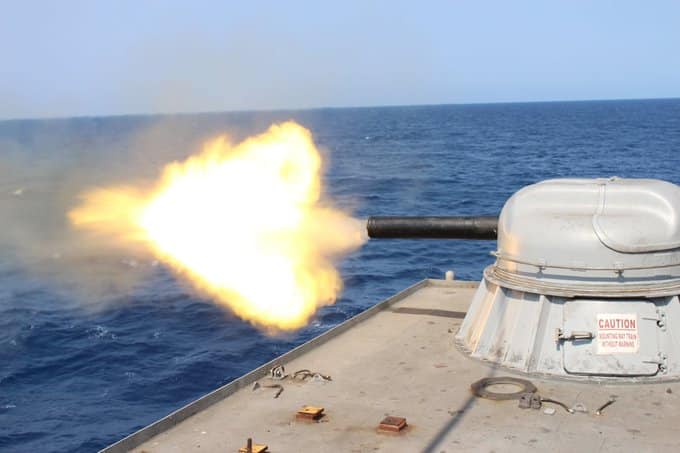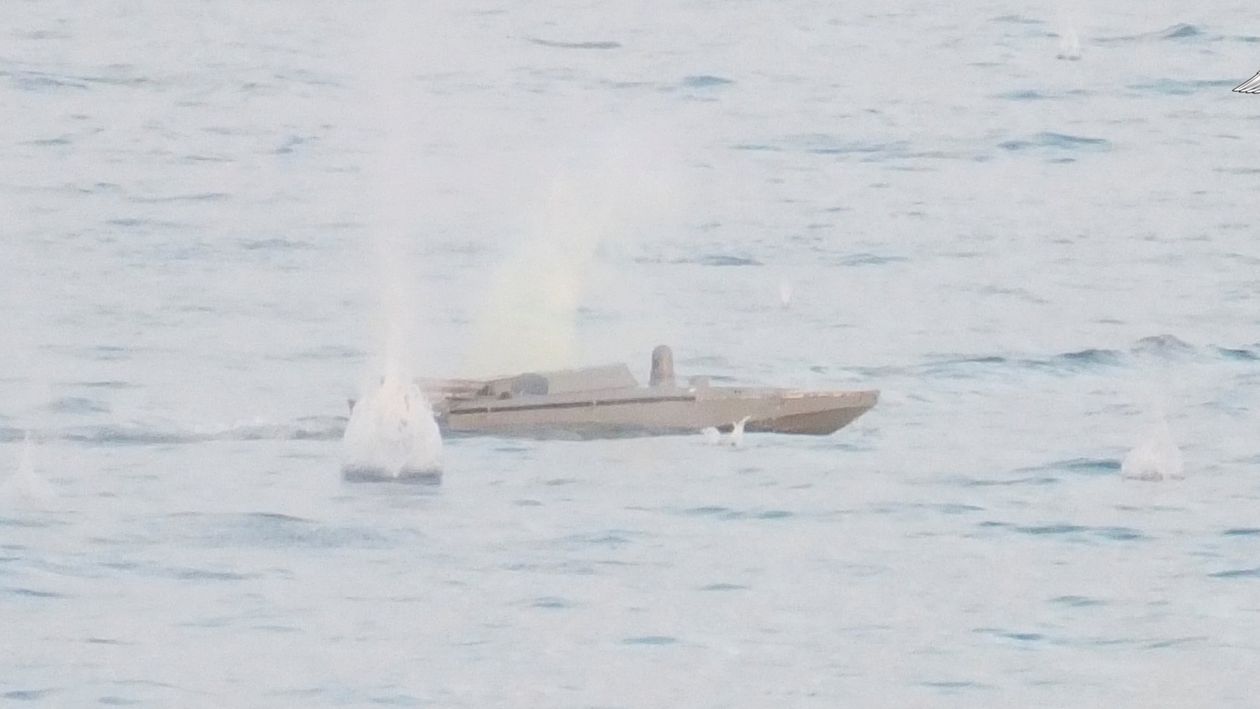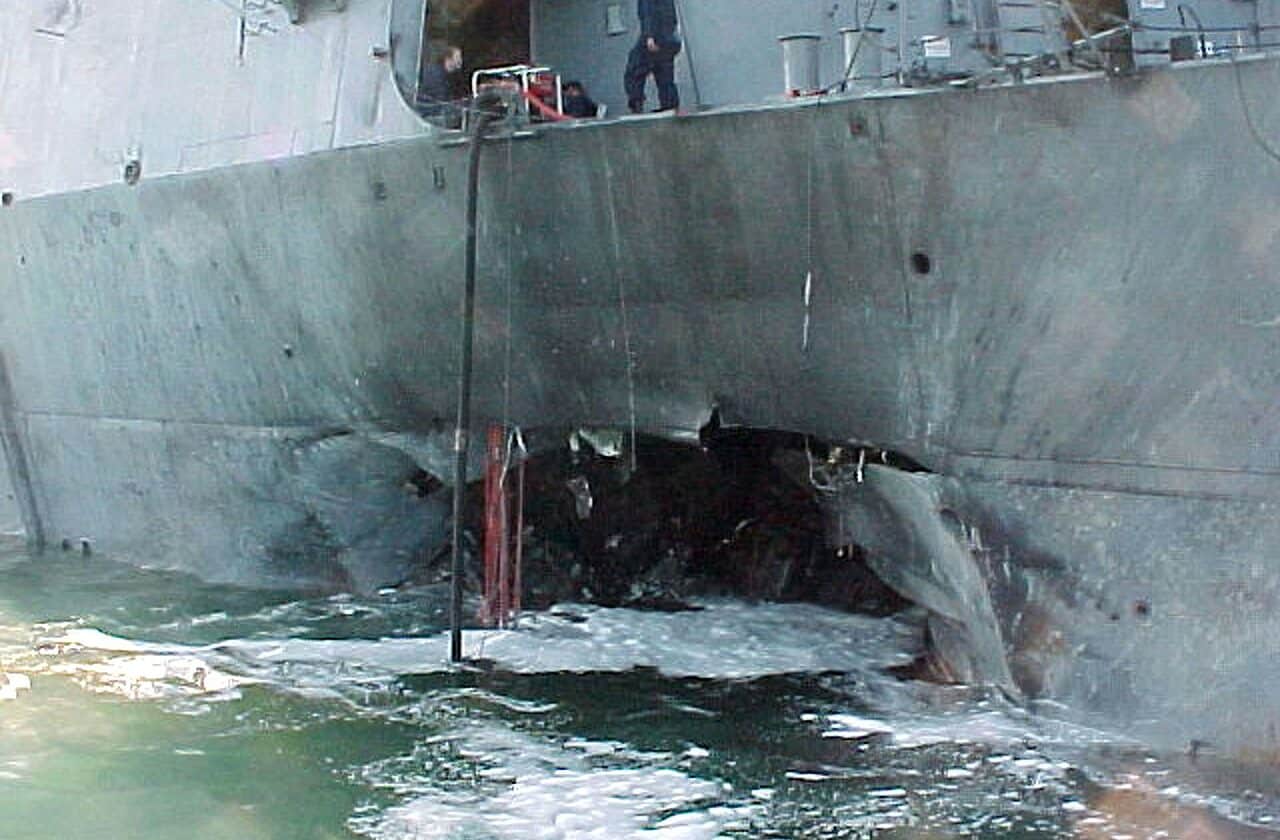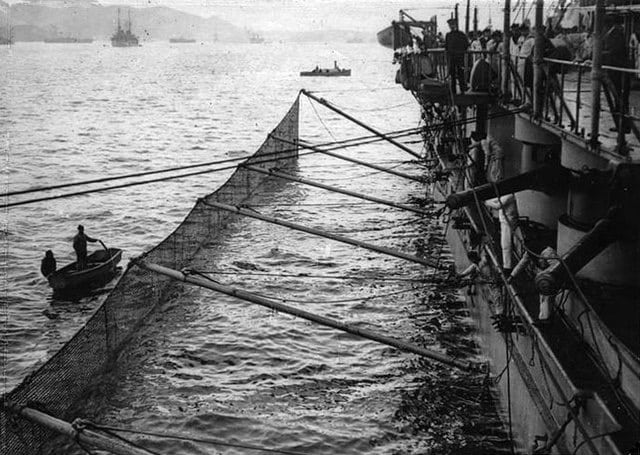In this section:

This article is brought to you by CERBAIR, the European specialist in anti-drone solutions.
This is not the first time that naval suicide drones have entered combat.
Already during the sinking of the Moskva or attack on small boats by aerial drones, drones demonstrated the threat they posed to naval units. Naval suicide drones are one of the novelties of the war in Ukraine.
Due to the lack of a navy, the Ukrainians are massively using remotely operated naval suicide drones to attack the ships of the opposing navy and attack critical infrastructure such as the Crimean bridge.
However, the effects of these weapons remained relatively modest. The best results were achieved against ships at dock, but attacks at sea had more mixed results. The small caliber artillery of the military ships managed to destroy the majority of the drones before they reached them.
However, a few ships suffered damage forcing them to undergo long weeks of repairs. This is, in itself, already a victory since it deprives the adversary of some of its ships, even if it is temporary.
However, with several months of experience using this type of drone, the Ukrainians seem to have evolved their tactics by focusing on saturation attacks in all directions.
This is what suffered, on February 1, 2024, the Ivanovets3 missile corvette. The attack appears to have involved around ten naval drones such as Mamay, Magura V5 and/or SEABABY which attacked the ship from all sides. This tactic was renewed on February 14, 2024 against the tank landing ship Caesar Kunikov, again successfully since the ship was also sunk.
If today it is the Russian Navy which must face this threat, all navies must prepare for it and a careful observation of events allows us to perceive some avenues for reflection.
The Tarantul defends itself
The Ivanovets corvette belongs to the Tarantul III class. It is armed, as main armament, with 4 P-270 Moskit missiles (SS-N-22 SUNBURN in NATO code) which are large supersonic anti-ship missiles (4,2 tonnes and a speed of 2800 km/h) 'a maximum range of 250 km.
These fast corvettes were designed to strike NATO military ships that approached the coasts of the Soviet Union using a harassment technique. They were not designed to have great autonomy at sea nor to have to venture far from the coast; they just had to get out quickly, fire their missiles at the enemy ships and return to port immediately afterwards.

This explains why these are relatively light ships, around 500 tonnes, having as additional armament only one 176 mm AK-76 cannon and two 630 mm CIWS (Close-In Weapon System) AK-30 cannons. . Anti-aircraft protection is limited to the carriage of very short-range ground/air systems (MANPAD).
Detection level, unsurprisingly, the ship is mainly equipped with a radar making it possible to designate anti-ship missiles and guide them towards their targets (34 K1 Monolit or Band Stand in NATO code). It also has a surface surveillance radar and fire controls for its guns.
All of the equipment is of an older generation and dates from the 1970s. The corvette Ivanovets seemed to have taken refuge in Lake Donuzlav, north of Sevastopol.
Buildings of this type are not of much use in the current war and the Russians therefore seek to shelter them as much as possible. The video clearly shows that the corvette has detected the threats since it fires its two AK-2 cannons against the drones.
We can clearly see the guns oriented on the port side of the ship, while, at the same time, another attacker approaches on the rear starboard and hits it, thus damaging its propulsion by bringing the building to a standstill.
A new drone comes to touch it once again on the stern and we then notice that the cannons are no longer firing and that the radars are no longer rotating. The damage suffered by the machines undoubtedly caused a general electrical outage. Then, at least two other drones will strike the ship on its port side and finish it off while the remaining cameras film the final moments of its agony.
The video released by the Ukrainian authorities is only a one-minute-and-a-half montage and does not reflect the full duration of the attack, which probably lasted several minutes.
It is unclear whether the corvette managed to destroy any of these drones. It's likely, the Russians have already released videos showing naval drones destroyed by these same cannons, but it is obvious that the corvette could not face so many threats at the same time.
If Russian ships are generally well equipped with close defense artillery, saturation always makes it possible to overcome defense capabilities.

The attack on the landing ship is less illustrated, however the videos released show that the ship's CIWS AK-630 cannons also returned fire against the naval drones, three of which were reportedly destroyed.
Protect ports and infrastructure
Quite quickly, the Russians set up, at the entrance to the harbor of Sevastopol, floating booms protected by light artillery responsible for destroying any naval drone that attempted to enter there.
In addition, reconnaissance flights are carried out, with helicopters or maritime surveillance planes, in order to detect and, if possible, destroy any naval drone that approaches the port. This was an opportunity to give back a role tontic seaplanes Be-12 which find their usefulness here to strengthen the means of surveillance.
It worked pretty well. The Sevastopol harbor was spared from this type of raid, which forced the Ukrainians to resort more to cruise missiles and aerial drones to attack this port. Likewise, Russian authorities have repeatedly announced that aerial patrols have detected and destroyed several naval drones approaching Crimea.
The Ukrainians then sought to strike naval units docked in an unprotected port and thus on August 4, 2023, a landing ship was damaged by a naval drone in the port of Novorossiysk.
We can assume that protections were quickly put in place, because this was the only operation carried out against this military port, even though it serves as a refuge for many units previously stationed in Crimea.
This same type of protection was placed at the Kerch bridge. We are witnessing a bit of a throwback when ports were protected by anti-submarine nets from which these floating booms are inspired.
Protecting ships at sea
Artillery:
Russian Navy ships have already foiled several surface drone attacks at sea using their artillery. However, this was not always 100%, some ships were damaged and above all, faced with a saturating attack such as the corvette Ivanovets and the tank landing ship Caesar Kunikov, the on-board artillery was not is not sufficient.
Basically, this modus operandi must worry all the navies of the world, because currently, no military ship of any country is prepared for this type of threat. It is even worse for ships not equipped with CIWS systems or small caliber guns which then have no means of defending themselves, even against one or two suicide drones.
This is a particularly acute danger, both for support ships, which are by nature poorly armed, and for civilian ships. While the impact of one or two suicide drones is unlikely to result in a complete sinking, except for very small units, this causes damage that puts the affected naval unit out of service for at least many weeks.

This threat is similar to what happened to the USS Cole in 2000 in the port of Aden. It had been hit by a boat loaded with around 400 kg of explosives, a military load similar to Ukrainian naval drones, which caused a hole in the hull. The ship was repaired and returned to service after 14 months of work which also consisted of upgrading the ship's radars and combat system.
Protective nets:
We could then see the reappearance of anti-torpedo nets, widely used around combat ships until the end of the First World War. But, if this solution is relevant in a port or at anchor, it cannot be used at sea: the hydrodynamic braking generated is prohibitive.

Since naval drones operate at water level, the protection must go a little lower than the waterline to prevent a drone from passing directly underneath. This would be a possible solution for the protection of civilian ships at anchor, but perhaps more difficult to apply to military ships which have less space for such an addition.
Electronic warfare:
Since naval drones are remotely operated in order to be able to find their target several hundred kilometers away, it would be possible to seek to cut the radio links between the drones and the operators.
Ukrainian naval drones can be remotely operated via a satellite link, Starlink, or by a direct radio-frequency link with an aerial drone which serves as a radio relay. During the first attacks, it was mainly the satellite link that was used, but since Elon Musk restricted the service in certain areas, the Ukrainians are now relying more on the radio link with airborne relay.
This is what the attack on the Caesar Kunikov shows, where part of the images broadcast by the Ukrainian authorities are images taken from an aerial drone which undoubtedly also served as a radio relay. They have sought to limit their dependence on a foreign system over which they are not masters.
It is always possible to hinder a satellite link by jamming the satellites concerned. It is not selective and it amounts to denying the entire service in a given area, it cannot be selective. However, it is not possible to detect the arrival of a threat by this means, the presence of signals not being specific to the use of naval drones.
Consequently, such a solution is only applicable as a preventive measure, without knowing whether there is a threat or not. However, radio frequency links can be more easily detected and identified. It would thus be easier to carry out reactive jamming upon detection of danger.
Drones thus deprived of their radio links will no longer be able to be guided towards their target. The other advantage of electronic warfare is that it provides protection against aerial drones which can be used for reconnaissance, as a radio relay or in attack against ships or port infrastructures as well as against surface ones.
The main combat ships do have electronic warfare systems, but these are primarily designed to counter missile homing or fire control. They do not cover the same frequency ranges and would, today, be completely ineffective against these drones. Ships lack a more global electronic warfare capability to take into account the threat represented by both air and naval drones.
“Low cost” mini-missiles:
Another option, potentially complementary to the others, would be to equip ships with guided rockets just capable of destroying light boats or “Low Cost” missiles like the Shahed.
Since naval drones cost significantly more than aerial drones, a few hundred thousand Euros (around €250 for a Magura V000), the use of this type of weaponry would remain economically sustainable.
Solutions exist such as the VAMPIRE system from L3 HARRIS or the FZ275 LGR 70 mm laser-guided rockets from THALES integrated into the LMP (Multipurpose Modular Launcher). It would therefore be necessary to equip ships with several dozen of these rockets so that they can face multiple attacks over 360°.
Power laser?
The first power lasers which should gradually begin to enter service in the years to come will be mainly intended for the destruction of aerial drones or rockets.
It will probably take a few more years of development before we see lasers powerful enough to destroy naval drones. But it is possible that this technology could complement or replace certain existing weapons.
However, these materials may not necessarily have the capacity to deal with saturation attacks and the presence of one or two powerful lasers may not be sufficient to deal with such an attack. This weapon still has the advantage of being capable of dealing with both air and surface targets.
Conclusion
Naval suicide drones are a new risk that is expected to grow. They are an alternative for nations or non-state organizations that do not have anti-ship missiles. It is a way, for traditional navies, to increase their volume and their offensive capacity, in particular thanks to saturation.
An attack combining suicide naval drones with a salvo of anti-ship missiles would be particularly complex to thwart. It took only 2 anti-ship missiles to sink the 12-ton Moskva, while it took a dozen naval suicide drones to sink a 000-ton corvette.
While drones are obviously less effective, they are much simpler to produce and deploy than missiles. In addition, their autonomy allows them to strike ships several hundred kilometers away.
This new threat calls for a response from the military navies which could be broken down into three parts:
• Mandatory presence of small caliber CIWS artillery systems capable of both providing short-range anti-missile defense and anti-surface drone defense. They could, ultimately, be supplemented or replaced by power lasers.
• Increase in electronic warfare means making it possible to thwart not only missile homing or fire control, but also drone communications, whether surface or aerial.
• Embark a system comprising several dozen Laser-guided rockets allowing small boats to be engaged at lower cost. This also requires us to think about putting in place, if necessary, protections at the entrance to our ports, because the war in Ukraine shows how vulnerable logistics bases can be.
CERBAIR

This article is proposed by CERBAIR.
As a company specializing in the fight against drones, CERBAIR proposes this article to highlight the growing importance of drones in zones of armed conflict. CERBAIR provides the most objective possible vision of these emerging threats and provides food for thought for defense actors.
CERBAIR is the French reference in the fight against drones for the detection, characterization and neutralization of unauthorized drones. Drawing on its expertise in radio frequency signal processing, CERBAIR offers this article to highlight the growing importance of the drone threat.
CERBAIR provides the most objective possible vision of these emerging threats and provides food for thought for defense actors.
Contact us for any request for protection against drones:
https://www.cerbair.com/fr/contactez-nous/

